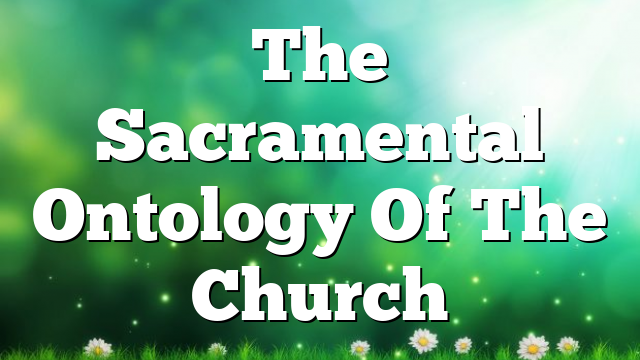Click to join the conversation with over 500,000 Pentecostal believers and scholars
Click to get our FREE MOBILE APP and stay connected
| PentecostalTheology.com



Pneuma 35 (2013) 157-161
The Whole Gospel for the Whole Person: Ontology, Affectivity, and Sacramentality
Dale M. Coulter
When Orthodox writers describe the deification of human persons, they usu- ally invoke the idea of an ontological change. The theological insight is that regeneration concerns a genuine change in human nature that unites the per- son to Christ and gives rise to righteous acts. This change does not simply initi- ate healing; it also begins to expand the capacities of human nature beyond their original limits. For the Latin tradition, the change occurs through an infused habitus that alters human existence or through the Spirit’s directly forming Christ in the soul. From this perspective, it would be reductionistic to describe Christian existence simply as an imitatio Christi, an ethical form of existence patterned on the words and deeds of Jesus of Nazareth. To reduce Christian existence to such a stance would amount to a form of Pelagianism that identifies putting on Christ with mere behavioral modification in light of moral norms. Christian existence is a renovatio or reformatio, Latin terms that translate anakainōsis (renewal) and metamorphōsis (transformation) respec – tively (Rom. 12:2; Titus 3:5). It is an alteration in the very form of human exis- tence that amounts to a fundamental renewal so that humans become novae creaturae.
Talk of an ontological change may seem odd until one considers the connec- tion to forming right affections (orthopathy). Affective transformation is about being formed in Christ and conformed to Christ. The operative word in all of this is “form,” which in Hellenism carried metaphysical freight. Human nature has a particular form or being that is a given, on the one hand, and yet can be shaped, on the other hand. In other words, there is such an entity as human nature and this nature is developmental. As innate dispositions, the affections are movements that arise from human nature and also form it in particular ways as persons habituate themselves to this or that set of objects. Forming Christ within involves reordering affective movements that have become “de-formed,” which in turn provide a new “shape” to the person.
© Koninklijke Brill NV, Leiden, 2013
DOI: 10.1163/15700747-12341346
1
158
D. M. Coulter / Pneuma 35 (2013) 157-161
Affections are also movements of the rational soul and therefore have a cog- nitive dimension. Desire, joy, anger, fear, and other affective movements all relate to some object. Humans desire this or rejoice over that, which presup- poses judgments of value. They take joy in what they value or they learn to value what they rejoice over. To view affections in this way is to get back behind the view of emotions as involuntary, irrational feelings that emerged and then became dominant in the late eighteenth and nineteenth centuries.1 It is unfor – tunate that the Holiness movement and pentecostalism took root at a histori- cal moment when the broader culture devalued the emotions so much, both in the staid values of Victorian life and the Gilded Age and in the development of the “feeling” view of emotions as products of sensation that, according to Dixon, William James promoted.
At least two corollaries follow. First, since one cannot sever the connection between movements of thought and affective movements, it follows that there is an intimate relationship between affections and beliefs so that affections determine beliefs and beliefs shape affective movements. Value judgments flow from the affective and cognitive dimension together, leading persons like Aquinas to describe the will as a rational appetite. The statement “I want ice cream” has an implicit judgment about its value. This judgment springs from the connection between the desire and its object. Second, the relational con- nections humans form through affectivity shapes them in fundamental ways. For this reason, classical writers like Aristotle and Cicero wrote about friend- ship in relation to the good life. Friends shape one another and promote flour- ishing or diminish it, which may be why Scripture pits friendship with the world against friendship with God (Jas. 4:4) while simultaneously claiming that God loves the world (John 3:16), with the implications that Christians should do so also. Humans take on a particular character or shape as they habituate their affections toward this object or that object. To claim that humans are homo liturgicus, as Jamie Smith does, is to equate worship with degrees of desiring.2
If I am on the right track, then transforming affective movements leads to a change in the nature of the person, not only in terms of the values held, but also in terms of the character that forms those values. Ontological change occurs in and through affective transformation because affectivity shapes
1 Thomas Dixon, From Passions to Emotions: The Creation of a Secular Psychological Category (Cambridge, UK: Cambridge University Press, 2003). The work of Martha Nussbaum, among oth- ers, has done much to recover the more ancient view of emotion and desire.
2 James K. A. Smith, Desiring the Kingdom: Worship, Worldview, and Cultural Formation (Grand Rapids, MI: Baker, 2009), 39-74.
2
D. M. Coulter / Pneuma 35 (2013) 157-161
159
reason and will, binding them together with value judgments based on rela- tional connections to objects outside the self. Affective transformation alters human being as it shapes those dispositions central to the relational nature of the person: it changes the heart and brings about a new configuration or character. It is the human person who instantiates human nature in a particu- lar way, and affectivity is central to that unique form of instantiation. Since humans are embodied creatures of emotion and desire, personhood is relational.
Pneumatology now must enter the picture because, although Christ is the form of the new creature, the Spirit brings this new form into existence. As Augustine suggests, the Spirit achieves this end as the divine love who alters human loves. The Spirit is that divine person whose movement within the heart begins to reorder affective movements and so alter a person’s habits of mind. The Wesleyan insight, ultimately originating from Christian mystical traditions, was to postulate the need for crisis encounters as the fuel of Chris- tian growth toward final perfection. One might combine this insight with the Protestant Reformers’ insistence on sola fide by thinking of faith as the first affective movement toward God ( fiducia), who has become the new object of desire. In the act of faith the cognitive and the affective unite as a vision of divine beauty unfolds amidst the affective turn. This is the nature of conversion — a turning away from slavery to the temporal toward the freedom of the eternal. Consequently, the encounter with God and its impact on human love is a triune event, an ecstatic moment in which the Spirit forms the Incar- nate Son and so ushers the person into the presence of the Father. The analysis thus far may wrongly lead to a privatized Christianity, a Plotin- ian ascent of the one to the One. At times Christians, including western pente- costal ones, have advanced just such an interpretation. It has taken a more robust, interdisciplinary approach to global pentecostalism to recover the insight (for pentecostals) that humans are socially embedded creatures. Upon entering the world, humans are caught up in a social imaginary.3 What Charles Taylor means by “social imaginary” is how individuals imagine their existence as part of a larger whole, which is usually expressed in and through stories, songs, and symbols. These stories convey sets of expectations (norms) about life that inform practices and the way in which practices alter norms. A social imaginary also includes pretheoretical constructs (such as a world view) that
3 Charles Taylor, Modern Social Imaginaries (Durham, NC: Duke University Press, 2004), 23-30. See also Smith, Desiring the Kingdom, 63-71, in which he argues for using social imaginary over worldview.
3
160
D. M. Coulter / Pneuma 35 (2013) 157-161
can be theorized upon, critiqued, and reinserted back into the social imagi- nary. Social imaginaries flow from social embeddedness, pointing toward the “storied” nature of human existence. Christian thinking always challenges and affirms social imaginaries and social embeddedness — which brings us to the current issue of Pneuma.
Affective transformation occurs while being caught up in a larger narrative, a new story into which persons become embedded that reshapes them and brings with it a new conscientization. This new conscientization is the vision that emerges with and initiates the act of faith. It is also a conscientization that unfolds through the ritual acts of baptism and Eucharist in which the believer encounters Christ afresh amidst his body and enters the drama of redemption, as Terje Hegertun’s article argues. Chris Green’s reflection upon the Emmaus- road encounter suggests that the Spirit’s work of reordering human affectivity enables believers to inhabit another reality, a new history that offers a different social imaginary. Such an encounter with the living Christ through the Spirit opens the person to Christ by forming Christ within and therefore brings about a different way of reading scripture, something that James Dunn highlights in his exploration of the Pauline contrast between the letter and the Spirit. In call- ing pentecostals an epicletic people, Johnathan Alvarado underscores Green’s contention that the Eucharist becomes formative for the whole people of God who “in the Spirit” are “re-storied.” Alvarado joins Daniel Castelo’s call for a more robust account of epiclesis.4 Finally, Samuel presents preaching as a par – ticipatory event all the way through in which the speaker and the listeners dia- logue with one another as they are caught up in the presence of the God whose story is being proclaimed through the inscripturated word. Each of these arti- cles reminds pentecostals of the importance of sacramentality, both as a theo- logical affirmation that created realities become vehicles of grace and as an explanation of how a vision of a deeper transformation of those same realities unfolds through the conscientization that is the Spirit’s affective transforma- tion of the person.
When pentecostals proclaim the whole gospel for the whole person, they have in view the way in which the gospel radically alters and fulfills human existence. The Christian life begins with a reformatio and renovatio of human nature. This reformatio marks the first stages of conversion while also initiating a formative process that culminates in immortality, incorruptibility, and the visio dei. Through ongoing moments of crisis, all of which are fundamentally
4 See also Daniel Castello, Revisioning Pentecostal Ethics: The Epicletic Community (Cleveland, TN: CPT Press, 2012).
4
D. M. Coulter / Pneuma 35 (2013) 157-161
161
sacramental, this renovatio also catches people up into the story of God that forms the people of God and, in an important sense, continues to be writ- ten by the Spirit of God. Paul’s declaration to the Corinthians that they were human letters communicating the wondrous work of God intimates as much (2 Cor. 3:3). This means that the social imaginary of the people of God encom- passes the full experience of human personhood as a lived and embedded real- ity. This new story absorbs other stories even as it forges an alternative consciousness, allowing believers to prophetically critique those stories that used to determine their own identity. The crisis of renovatio frees persons to dialogue with and critically engage their own stories. It is a whole gospel, pro- claiming a salvation that changes human nature through the forging of one new humanity conformed to Christ through the Spirit. The articles of this issue, therefore, call pentecostals to explore more deeply the intersections between ontology, affectivity, and sacramentality.
5




Most Talked About Today